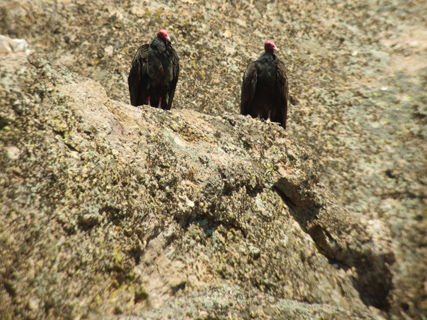
Lives eclipse the death of a condor
As I rambled along a ridge near the top of Pinnacles National
Monument last Saturday, distant movement caught my eye and I
stopped.
I was unaccompanied, and had no schedule to keep. I had no
companion with me, so I did not have to concern myself with setting
an appropriate pace. I was reminded again of what a privilege it is
to be able to hold still in the wilderness. The world reveals
itself to those who slow down.
Lives eclipse the death of a condor
As I rambled along a ridge near the top of Pinnacles National Monument last Saturday, distant movement caught my eye and I stopped.
I was unaccompanied, and had no schedule to keep. I had no companion with me, so I did not have to concern myself with setting an appropriate pace. I was reminded again of what a privilege it is to be able to hold still in the wilderness. The world reveals itself to those who slow down.
I’d attained the ridge via the Condor Gulch Trail. As it wound through chaparral, the brush sang out with birdsong. Blue-gray gnatcatchers chattered. Oak titmice sparred. Warblers were under the canopy, not in streamside thickets where I’d think to look for them. I’d already sat for a while to watch the titmice, mousy colored birds with cardinal-like crests, as they carried on.
This time, the movement that drew my attention came as I was on a section of trail offering little in the way of places to sit. It offered even less in the way of level ground.
The dark speck in the sky grew closer, and the speck materialized as a peregrine falcon. A single pair nests at Pinnacles, and at this time of year, any raptor making the mistake of getting too close to their aerie can expect a visit from the fastest animal ever to inhabit the planet.
This time, a red-shouldered hawk, drifting on the breeze that lifted over the ridge, was the target. As the falcon dove – some accounts claim they are capable of diving at speeds of 200 mph or more – the hawk feinted as it tried frantically to escape from the falcon’s no-fly zone. There are an estimated 250 pair of peregrine falcons in California, and to watch one defending its young is a Wild Kingdom moment of the first degree.
Soon, the hawk was gone and the show was over. I rambled for a while until the next show presented itself. A group of turkey vultures, looking like old-time undertakers, sunned themselves from rocky perches.
It was like that all day, distractions looming everywhere that invited me to stop walking and start watching.
Of course, I had no way of knowing at the time that one of Pinnacles’ rarest residents was lying dead in a field.
One of the young California condors released at the monument last month was found that day. There was no external clue of what might have taken the bird.
Condors are magnificent, dwarfing other raptors as they float through the sky, soaring without a wingbeat. Fewer than 130 fly in the wild, so the loss of one of the Pinnacles flock is significant.
But tragic?
The bird, bred in captivity, died tasting the wilderness that was always its destiny. For that bird, as for us all, death and life are indelibly bound together.
The fact that this is the first bird released at Pinnacles to be found dead should be bigger news than its death.
Wild animals have to learn many skills to survive, and many do not.
Think about a beach teeming with gulls. The large Western gull – the one with a dark gray mantle over its wings and salmon colored feet and legs – takes four years to attain that adult plumage. In between, it goes through a series of molts that gradually change its appearance.
If that flock is typical, perhaps half the birds will be wearing subadult plumage. But the birds can live 20 years or more. That would seem to lead to flocks heavily skewed toward adult birds. But many of the young birds will never learn how to be good enough at being gulls to survive long enough to reach full adulthood. Only the best survive.
Each fall there are reports of young raptors, found exhausted in odd locations. They were not able to gain the nourishment and strength needed to complete migration.
A condor died this week. But 129 others lived in the wild.
Not long after I arrived at a dinner event Tuesday evening, a friend approached. He knew of Saturday’s death, but that’s not what was on his mind. On the same day, he’d seen a free-flying condor, high over the fairways at Ridgemark. It was life, not death, that captured his excitement.









